
Written and Photographed by Peter Harrigan
“The higher flights of desert-craft are as uncanny as the soarings of an Einsteinian brain.... In both cases the responsible factor would seem to be not instinct...but education. The habit, derived from generations of instruction..., of observing the material facts and applying a certain train of reasoning...can alone account for the miracles of the expert. And so in the Arabian desert the good guide is he who observes carefully, deduces accurately and remembers faithfully.”
— H. St. John B. Philby, The Empty Quarter, 1933
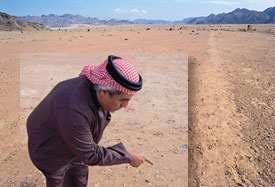 |
 |
| Above: Abdulhadi Saleh al-Murri, administrator of some 100 professional trackers in the Saudi government’s “Tracker Corps,” explains how to determine the direction of a vehicle’s travel from its tire tracks. Background photo: Camel hoofprints smooth a desert path in western Saudi Arabia. Skilled trackers read such trails as easily as you read the words on this page. |
 ake a look around you,” says Abdulhadi Saleh al-Murri, declining a fourth pouring of Arab coffee with a shake of the thimble-sized cup. “As well as our host, at least 10 of the guests in this majlis are notable trackers. All of them are from the Murrah tribe. Half of them work with me in Riyadh.”
ake a look around you,” says Abdulhadi Saleh al-Murri, declining a fourth pouring of Arab coffee with a shake of the thimble-sized cup. “As well as our host, at least 10 of the guests in this majlis are notable trackers. All of them are from the Murrah tribe. Half of them work with me in Riyadh.”
Abdulhadi Saleh is among more than a dozen relatives and friends who have arrived over the course of the morning at the home of Shaykh Jaber Mohammed al-Amrah al-Murri. Jaber Mohammed works not with Abdulhadi Saleh in Riyadh but as general manager of some 250 rangers employed by Saudi Arabia’s National Commission for Wildlife Conservation and Development (NCWCD). Located on the outskirts of the small town of Haradh in central Saudi Arabia, Jaber Mohammed’s modern one-story home is set like a sentinel overlooking the northern fringe of the Rub’ al-Khali, the Empty Quarter. New arrivals work their way around the assembly, greeting each in turn according to Murrah tradition: a single kiss on the nose or forehead and, for a foreign guest, a warm, firm handshake. In every encounter, eye contact is resolute.
Abdulhadi Saleh is the administrative head of some 100 professional trackers employed by the Ministry of the Interior. They make up an elite, uniquely Saudi crime-fighting and conservation corps that has existed, in one form or another, since the early 20th century. Some scholars believe that their skills, like those of trackers in other parts of the world but here honed over millennia in the desert, point toward the very origins of human rationalism and scientific thought.
 |
 |
 |
 |
| Top: Though he grew up riding in pickup trucks more than on camels, Captain Hamid al-Murrah grew up “a reasonably good tracker,” he says. Flying out of the Taif airstrip of the National Commission for Wildlife Conservation and Development (NCWCD), he monitors radio-collared Arabian oryx at the Harrat al-Harra wildlife reserve. Above: Many rangers at Saudi wildlife reserves grew up as trackers. Along the perimeter fence of the Mahazzat al-Sayd reserve, rangers patrol for signs of poachers. |
Raised a nomad and well-grounded in desert lore, Abdulhadi Saleh took his interest in tracking and guiding a step farther than many, enrolling in the Prince Naif College of Security Studies in Riyadh (now Prince Naif Arab University), where he wrote a dissertation on those subjects for his master’s degree in criminology. His trackers today are “deployed in shifts on constant call. They provide a specialist service for the Central Province and the capital, Riyadh, in the fight against crime and, more recently, in the war on terror,” he explains. (See “Tracking Terrorism.”)
When I mention that tracking schools have been established in the United States in recent years that keep alive some of the knowledge developed by Native Americans, Abdulhadi Saleh notes the decline of tracking skills in his own country, without any such schools on the horizon as yet. Other than his own thesis, he cannot recall a single recent book in Arabic on the subject of tracking or desert guiding: In Saudi Arabia, he says, there are only living practitioners, and their numbers are declining.
“In the past, trackers emerged and were picked for their specific skills as well as for their character. It was a big responsibility and an honorable status within any tribe and clan. Trackers were decision-makers and often leaders,” he explains. “You’ll see their ability today.”
If the feats of which I had been told were even partly true, then here, in the spacious, cushioned parlor at the northern edge of the Empty Quarter, was a gathering possessed of some of humanity’s most refined powers of perception, detection and memory. Tales abound throughout Saudi Arabia of trackers’ almost casual ability to read the sands with no more difficulty than a modern city dweller might read printed pages: “So-and-so passed this way three days ago with eight men and 10 camels. Three were carrying dates and the rest were lightly loaded. And look, the white camel has gone lame.” Then there is a classic Holmesian tale about the Bedouin who, after four days on the trail of a camel-mounted fugitive, came upon a settlement where his quarry had taken refuge. He demanded, “Bring out the man with the eye ailment who rode in one night ago on a white camel with no tail that’s also blind in one eye.” The tracker had taken in clues: the position of the camel’s droppings relative to its rear footprints, the evidence of lopsided grazing on shrubs and a tell-tale finger-smear on a campfire stone near which the pursued rider had applied the juice of a desert plant used to treat the eyes.
While some of the tales hint at origins in legend and oral poetry, and some recur with frequency, few dispute their basis in fact.
“See for yourself,” says Jaber Mohammed. He gestures for his guests to rise. “Test anyone here you like.”
 had first met Shaykh Jaber Mohammed some weeks earlier as my quest for desert trackers was beginning in the office of Abdulaziz Abu-Zinada, general secretary of the 18-year-old NCWCD. Abu-Zinada is responsible for protecting the fragile ecosystems of 15 wilderness reserves that together measure more than 87,445 square kilometers (33,762 sq mi)—the area of Maryland or Moldova. He spoke of captive breeding and radio-collar monitoring as well as the NCWCD’s nine aircraft and more than 300 vehicles that rangers use to watch for poachers. Amid the technology, I wondered, is there still a place for trackers?
had first met Shaykh Jaber Mohammed some weeks earlier as my quest for desert trackers was beginning in the office of Abdulaziz Abu-Zinada, general secretary of the 18-year-old NCWCD. Abu-Zinada is responsible for protecting the fragile ecosystems of 15 wilderness reserves that together measure more than 87,445 square kilometers (33,762 sq mi)—the area of Maryland or Moldova. He spoke of captive breeding and radio-collar monitoring as well as the NCWCD’s nine aircraft and more than 300 vehicles that rangers use to watch for poachers. Amid the technology, I wondered, is there still a place for trackers?
“Of course,” Abu-Zinada replied. “I’ll call our best, Shaykh Jaber Mohammed al-Amrah al-Murri. His father tracked for rulers, and he himself scouted and tracked with Sa‘ud Al Faisal ibn ‘Abd al-‘Aziz [now Saudi Arabia’s foreign minister] in the days when the prince was an avid falconer.”
An unassuming man whose face shows the rigors of some 60 years of desert life, Jaber Mohammed arrived at Abu-Zinada’s office with a clutch of relatives. For two hours we sat at a conference table and listened to tales of Murrah trackers. It was here that he invited me to his Haradh home to meet the others.
The Murrah, I learned, are so renowned as trackers that in Saudi Arabia today the generic word for any tracker, regardless of background, is murriyah. Abdulhadi Saleh’s corps is known as Al-Mujahidi al-Muriyyah, which means, loosely, “the tracker corps.” In the early days of Saudi Arabia, when King ‘Abd al-‘Aziz used the Murrah to help bring law and order to his new nation, he is said to have remarked, “We have the telegraph overhead and the trackers on the ground.” By the time the king died in 1953, nearly every police, frontier and administrative station had a tracker posted to it—more often than not, it was one of the Murrah.
Historically the Murrah are counted among the 20 leading Bedouin tribes of the Arabian Peninsula. They range with their camel herds over a territory of gravel plains and sand dunes that is larger than France, and that is also one of the least hospitable, most sparsely populated regions on Earth. Ceaselessly using the acute observation skills and faultless memory that survival requires, they have for centuries navigated their families and herds with pinpoint precision over nearly featureless terrain by day and night.
Donald Cole, who spent two years with the Murrah in the late 1960’s and who is now a professor of anthropology at the American University of Cairo, says that among the Murrah and other tribes, “young boys were left to search for stray camels. They got to know their animals by name and by their tracks, and they were always able to tell which tracks were made by their own people. The Murrah were the most traditional of pastoral nomads, and their life and environment fostered tracking. They grew up looking at tracks and were taught the skill explicitly. As they got older, they were casually informed by sitting and listening to the stories of their elders.”
In addition, the Murrah’s skills go beyond tracking into the more distinctly human field known in Arabic as firaasa. This is an age-old skill by which lineage and blood relationships can be determined by scrutinizing feet and faces or, in some cases, by reading footprints. In old Arabia, the term ka’if was used to describe someone who could not only follow and interpret tracks on the ground but also establish kinship by likeness—primarily of the feet.
 fter lunch, we climb into Jaber Mohammed’s four-wheel-drive GMC to search for terrain to use as a proving ground for a master tracker. Other vehicles with other guests follow in a motorized caravan, but one man stays behind: Mohammed Ali al-Amrah al-Murri, whose skills will be put to the test. He’ll get a call—by mobile phone, of course—when we are ready. Western texts refer to practice and testing sessions such as this as “dirt time.” Some recommend constructing and using sandboxes for practice, but we have much of a continent’s worth of sand before us. After a few kilometers, Shaykh Jaber Mohammed finds a patch he likes. Upon inspection, the ground is hardly fresh. It is already deeply criss-crossed with tire and animal tracks.
fter lunch, we climb into Jaber Mohammed’s four-wheel-drive GMC to search for terrain to use as a proving ground for a master tracker. Other vehicles with other guests follow in a motorized caravan, but one man stays behind: Mohammed Ali al-Amrah al-Murri, whose skills will be put to the test. He’ll get a call—by mobile phone, of course—when we are ready. Western texts refer to practice and testing sessions such as this as “dirt time.” Some recommend constructing and using sandboxes for practice, but we have much of a continent’s worth of sand before us. After a few kilometers, Shaykh Jaber Mohammed finds a patch he likes. Upon inspection, the ground is hardly fresh. It is already deeply criss-crossed with tire and animal tracks.
I am wary: This trampled, pockmarked patch looks entirely unsuitable for serious “dirt time,” and the Murrah are renowned for their sense of humor and their fondness for practical jokes. After Jaber Mohammed’s hearty lunch and generous infusions of coffee and tea, under a sky heavily overcast and facing a stiff wind scented with winter rain, the Murrahs’ spirits could hardly be higher.
Jaber Mohammed takes me by the hand and explains that this makes the test all the more complicated. “Choose any three of them,” he says, gesturing to the several dozen men now gathered. “Make sure they are the same size.”
I select three men of apparently similar seniority and stature. Jaber Mohammed lines them up, and, arms linked, they saunter barefoot for about five meters (16') over the sand. Within seconds of their rejoining the onlookers, I have lost their tracks in the confusion of the other marks.
“Which man was in the middle?” I ask Nawaf al-Rasheed, my driver and translator, who—importantly for my confidence—is not a Murri.
“Don’t worry, I can remember,” he says.
“But can you see which tracks he made?”
“I’m not so sure about that. They’re kind of all mixed up,” he answers.
A car draws up, and out steps the imposing figure of Mohammed Ali al-Amrah al-Murri. Wearing heavily tinted sunglasses, sporting a generous beard on a square face that I am told is unusual for a Murri, his stern, focused countenance appears to fit well the task ahead.
“Look here,” Jaber Mohammed bellows to him over the wind, pointing to the sand. “These are the three sets of tracks. The one in the middle is the thief! Find him!” He grins.
Mohammed Ali leans forward. The wind catches and throws his red headscarf across his face so that only his dark glasses are visible. Looking only forward, he does not stop and stare but strides purposefully directly over and through the area of tracks. After just a few paces, he turns back toward the group. The tracks have received his seemingly casual scrutiny for no more than a few seconds.
“He’s walking all over the tracks. How can he possibly know what he’s looking at?” I say to al-Rasheed.
“He can read,” says one of the young Murrah, sensing our bewilderment.
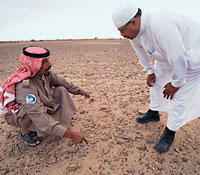 |
 |
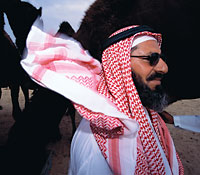 |
 |
| Top: In the Mahazzat al-Sayd reserve, ranger Sfayed al-Bugami, left, and bird ecologist Mohammed al-Shobrak found tracks of the lappet-faced vulture that demonstrated that the bird is a predator as well as a scavenger. Above: In a demonstration of his skills, tracker Mohammed Ali al-Amrah al-Murri marched over the tracks, obscuring them as he went. Once he had consigned them to memory, the tracks themselves were of no further use. “He can read,” explained one of the Murrah. |
Reading tracks, says Tom Brown, Jr., tells us everything about the animal or person that made them, “its actions, reactions, its condition, whether it is full or hungry, thirsty or tired, healthy or sick, even what it is thinking or feeling.” As one of the leading trackers and outdoorsmen in the United States, Brown founded a tracking-oriented survival school in the Pine Barrens of New Jersey and, over the past 45 years, has written some 15 books on the subject. “In essence, what I am saying is that one can know an animal or human far better through the tracks it makes than by actually seeing it,” he contends. Like his Murrah counterparts, Brown also regularly works for and instructs law enforcement agencies and rescue services.
Brown—like other western experts—contends that tracks are in fact as distinctive as fingerprints. What makes them unique is not their out-line—mere prints are “dead tracks”—but an infinite combination of more than 5000 definable pressure-release points. These are shaped and thrown up in and around the track in the moments the impressions are made.
Jaber Mohammed calls forward six of the onlookers, including the three whom I’d chosen to make the tracks. In rapid succession they parade past Mohammed Ali. He waves each one on impatiently, affording each new set of tracks only the briefest of glances. After the last one walks by, the old tracker stands back and quickly separates out the three who made the initial tracks. With his stick he points to the “culprit” who had walked in the middle.
I am stunned, both by his success and by his memory. He had marched over the tracks, obscuring them as he went and not once referring back to them. Once he had consigned them to memory, the physical tracks were apparently of no further use to him.
Then Jaber Mohammed says, “We will do it again, this time with 20 men in the walk-by, and six initial sets of tracks instead of only three.”
 uch remarkable powers of memory are apparently not unusual among trackers, and can be found well beyond the Murrah. In the small settlement of al-Muhayh, some 600 kilometers (375 mi) west of Riyadh, I met one of that area’s best trackers, Mutlaq Ghaib al-Mugati, through Sulaiman al-Salem, head of the government district administrative office. Al-Salem spoke proudly of al-Mugati’s accomplishments, including establishing both the mothers and the owners of stray baby camels, applying firaasa to help decide cases of lineage, apprehending criminals and finding missing people.
uch remarkable powers of memory are apparently not unusual among trackers, and can be found well beyond the Murrah. In the small settlement of al-Muhayh, some 600 kilometers (375 mi) west of Riyadh, I met one of that area’s best trackers, Mutlaq Ghaib al-Mugati, through Sulaiman al-Salem, head of the government district administrative office. Al-Salem spoke proudly of al-Mugati’s accomplishments, including establishing both the mothers and the owners of stray baby camels, applying firaasa to help decide cases of lineage, apprehending criminals and finding missing people.
What, I asked al-Mugati, has been your most notable achievement?
He recalled a theft where he was asked to examine the tracks but after-ward could find no one in the area whose prints matched. “A year later I was at mosque in a town a few hours away from here, and I spotted a pair of sandals at the door. After the prayer, I waited for the owner, and I confronted him. He immediately confessed to the theft he had committed a year ago. Once I’ve looked at tracks I never forget them, nor the person and the footwear that made them.”
Al-Salem claimed that, without the memory and skills of al-Mugati, his own job and reputation would have been on the line more than once. For example, he said, “we had held a suspect for nearly a year after a series of unusual robberies in the area. There was pressure on us to close the case. Al-Mugati had been sent to the various scenes and had taken with him a pair of shoes from the suspect’s home. Although they matched the tracks at one of the crime scenes, the owner of the shoes did not admit to the thefts.” Finally a team of senior officials descended on the town with the case file. “They told us to lead four men, including the owner of the shoes, out over sand. Al-Mugati was then called in.”
Al-Mugati took up the story. “‘Those,’ I said, pointing to one set, ‘are tracks made by the shoes that were at the scene. But the wearer is not the thief.’ And then I pointed out another set. They were not made with the shoes that were at the crime. But I could see that the man who made those tracks was the thief. Every person has a different way of walking, and when I look at tracks, I can see faces,” explained al-Mugati.
The thief’s ploy of using someone else’s shoes had failed, and “the major almost fainted,” said al-Salem.
Such satisfactions aside, the two agreed nonetheless that today the job of an official tracker is losing its appeal. “The pay is modest, and there are obvious disadvantages to the profession. People in a small community can be antagonistic toward one of their own doing this job,” said al-Mugati, who remembers being set tracking tests when a child. “These days young, educated policemen do not look up to trackers as they used to. They say they now have dna and other technology to help them.”
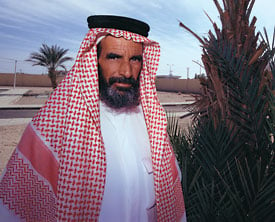 |
 |
| “Every person has a different way of walking, and when I look at tracks, I can see faces,” says Mutlaq Ghaib al-Mugati, a tracker whom the government calls upon for detective work in the western town of al-Muhayh. |
 n the mountains south of the resort city of Taif, Mohammed al-Shobrak is a bird ecologist with the National Center for Wildlife Research (NCWR). He has spent eight years in the field researching the lappet-faced vulture (Torgos tracheliotus). He knows and respects both the rangers’ tracking skills and the uses of dna and other tools of modern science.
n the mountains south of the resort city of Taif, Mohammed al-Shobrak is a bird ecologist with the National Center for Wildlife Research (NCWR). He has spent eight years in the field researching the lappet-faced vulture (Torgos tracheliotus). He knows and respects both the rangers’ tracking skills and the uses of dna and other tools of modern science.
“I’ve used tracks to advance our knowledge of this bird’s behavior, and I’ll show you how and where it happened,” said al-Shobrak, whose family comes from the al-Sa‘ar tribe of the southern fringes of the Empty Quarter. “I guess I still have some of the innate abilities of nomadic desert dwellers. Some people refer unfairly to the al-Sa‘ar as ‘wolves of the desert,’ and here I am studying vultures with three-meter (10') wingspans.”
Escorted by ranger Sfayed al-Bugami, we drove several hours east to the world’s second-largest fenced wildlife reserve, Mahazzat al-Sayd. Its perimeter of 230 kilometers (150 mi) protects reintroduced, captive-bred endemic species, including Arabian oryx, red-necked ostrich, gazelle and houbara bustard—all species prized by poachers.
“Look. Here is where I found the vulture tracks,” said al-Shobrak. Not long ago, he said, he deduced from bits of claws and skin in the pellets that vultures regurgitate that they were eating spiny-tailed lizards (Uromastyx aegyptius), called dhub in Arabic.
 |
 |
| Gazelle tracks in damp sand make for easy reading. The uniqueness of each impression offers a tracker clues to what the animal was doing, its size and condition, and how long ago it passed. |
“I found vulture tracks that led to the burrow,” he said. He pointed to the site of his discovery. “See, right behind the opening there, the tracks stopped. The deeper talon impressions revealed that the bird had remained there motionless and waiting. The dhub must have emerged from its burrow to bask in the morning sun. Perhaps it thought the shape crouched behind it was a bush. But the tracks and other spoor revealed a ferocious struggle, and one dead lizard eaten on the spot.” Helped by rangers, al-Shobrak had established that the bird was acting as a predator—a fact well known to the Bedouins, but contrary to science’s classification of the bird as a scavenger.
Later, as the sun dropped toward the distant Hijaz mountains, al-Bugami picked up the large, distinctive tracks of a red-necked ostrich (Struthio camelus camelus), now being captive-bred and introduced at Mahazzat al-Sayd by the NCWCD. Its close relative, the Arabian ostrich (Struthio camelus syriacus), had roamed across the gravel and sandy steppes of much of inland Arabia until hunting and increasing desiccation led to its extinction half a century ago.
 |
|
Encounters between the Murrah and foreign travelers became frequent only in the 20th century. The Arab of the Desert, written in 1949 by H. R. P. Dickson, is still considered a standard on Arabian Bedouin desert life and ways. Born in Syria in 1881, Dickson had the good fortune to be suckled by a Bedouin woman, which made him a blood brother of her tribe, the ‘Anizah. He spoke Arabic before he could walk, and
he is one of the few writers who provides more than a passing reference to the subject of tracking, offering in his book a brief chapter, “Desert Guides and Trackers.”
In 1935, Dickson met with Mutlaq al-Musailim, the paramount chief of the Rashaida, some of whom were renowned as guides. While the best of Shaykh Mutlaq’s people, including Ibn Hadhabba, guide for King ‘Abd al-‘Aziz, could find their way anywhere, anytime, and never forgot a desert feature, the chief admitted freely to Dickson that those of his tribe were not trackers.
“The palm in this science goes easily to the Murrah tribe,” wrote Dickson, observing that tracking was called ma’rifat al-jarrah, distinct from ma’rifat al-dalala, or guiding. The latter implied knowledge of landscape, terrain, flora, fauna and the night sky, whereas the former was based on the marks of a person or animal’s passing: footprints, spoor and other signs. Shaykh Mutlaq contended that “the Murrah skill was so great that following the tracks of a human female a tracker could say whether the person was married or single, and whether she was pregnant or not.”
|
We followed the ostrich’s tracks over rough, sandy ground. Al-Bugami used the low sun to better see shadows and relief. “Here it stopped to eat from this plant. And here it began to turn to the left,” he said, pointing to several faint prints that, to one not trained in tracking, were as inscrutable as the footprints of the men outside Shaykh Jaber Mohammed’s house. Soon we reached an area of broken granite.
Al-Bugami continued to move briskly and confidently over the stony ground, pointing with his stick to where marks appeared. In most cases they were barely perceptible, and we were unable to follow his references unless he actually touched them. We stopped. “Look,” said al-Shobrak, “that pebble was dislodged by the bird. It has perhaps been moved for the first time in thousands of years.”
Al-Bugami was well ahead of us. He was tracking using time-honed skills of prediction, anticipating where the ostrich was going as it ran over the hard ground, leaving tracks more than two meters (6 11/42') apart. Rather than hesitating to seek out spoor, al-Bugami looked ahead and maintained his pace.
Tracker Louis Liebenberg calls such intuitive tracking a form of “hypothetico-deductive reasoning.” “The art of tracking is a continuous cybernetic process that represents a constant interplay or interaction between hypotheses and the logical consequences they give rise to,” says Liebenberg, who specializes in evaluating trackers in southern Africa. Author of several books on tracking, he also develops tracking software. In his book The Art of Tracking (2001, New Africa), he argues that trackers use the very same intellectual and creative abilities as physicists and mathematicians. In historical terms, he maintains, tracking “represents the origin of science itself and therefore the oldest continuous traditional knowledge practices of humans.”
 |
 |
| The tracks of the houbara bustard, favored by hunters for its abundant meat, are now among the rarest in the desert. |
 hile al-Bugami works the ground of Mahazzat al-Sayd, patrolling the reserve’s perimeter, Captain Hamid al-Murrah is tracking radio-collared Arabian oryx (Oryx leucoryx) from a single-engined Maule STOL reconnaissance aircraft above another reserve, called Harrat al-Harra, in the Empty Quarter. “I found it easy to mentally pinpoint places below and guide rangers to the spot by radio even when the aircraft had left the area,” he explained. “I seem to remember the big picture below without trying: details like colors, rocks, landforms and shapes, trees and plants, tracks, roads, gullies, dunes and other features.”
hile al-Bugami works the ground of Mahazzat al-Sayd, patrolling the reserve’s perimeter, Captain Hamid al-Murrah is tracking radio-collared Arabian oryx (Oryx leucoryx) from a single-engined Maule STOL reconnaissance aircraft above another reserve, called Harrat al-Harra, in the Empty Quarter. “I found it easy to mentally pinpoint places below and guide rangers to the spot by radio even when the aircraft had left the area,” he explained. “I seem to remember the big picture below without trying: details like colors, rocks, landforms and shapes, trees and plants, tracks, roads, gullies, dunes and other features.”
Though pickup trucks had replaced load-carrying camels by the time he was born, al-Murrah recalled moving with the herds. “I was brought up in the desert for 14 years and went to a mobile school that traveled with us. I got used to focusing on the natural things around me and was a reasonably good tracker.” Twelve years ago, he secured a job as a ranger, and his ability to mentally map and remember large areas earned him a reputation and, eventually, his pilot’s rank and his own Maule.
The right-brain ability to absorb and remember landscapes may be a key to understanding tracking abilities that seem so uncanny to those who lack the skills. “Each track contains within its boundaries a miniature topographic map which reveals the maker’s secrets,” says Tom Brown, who attributes his own skills to instruction from an Apache elder called Stalking Wolf. “You read the pressure releases as you would a topographic map. In a way, the same forces that create our grander landscapes also work on the miniature landscapes of the track.” It is here that the abilities of both trackers and guides converge to draw on memory and interpretation of physical landscapes at any scale, from millimeters to kilometers.
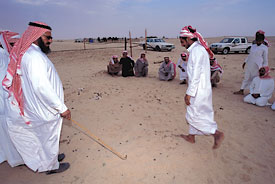 |
 |
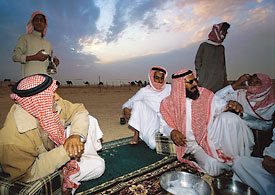 |
 |
| Top: “Dirt time” for tracker testing: Mohammed Ali al-Amrah al-Murri, left, examines the footprints of 20 “suspects” one at a time, matching them in his mind with the tracks of six men who passed over the same ground a few minutes earlier. Above: Mohammed Ali and other Murrah relax after an afternoon of testing their skills. |
 esides crime-fighting and conservation, the trackers’ talents are still essential in another arena: hunting. With the coming of motorized vehicles, sport hunting with falcons became widely popular in Saudi Arabia, and falconers employed Bedouins to track their birds’ quarries. Traditionally, houbara bustard, stone curlew, desert hare and gazelle were the species that a Bedouin could usefully hunt for the pot, and the houbara was the prize among them. Weighing up to three kilograms (nearly 7 lb), capable of outsmarting and outflying all but the best falcons and so superbly camouflaged as to be virtually invisible on the ground, it is also the sport hunter’s favorite prey. But today, with the houbara population dwindling fast throughout the Arabian Peninsula, hunting the bird is permitted in Saudi Arabia only during a short winter season, and a total ban applies in protected areas.
esides crime-fighting and conservation, the trackers’ talents are still essential in another arena: hunting. With the coming of motorized vehicles, sport hunting with falcons became widely popular in Saudi Arabia, and falconers employed Bedouins to track their birds’ quarries. Traditionally, houbara bustard, stone curlew, desert hare and gazelle were the species that a Bedouin could usefully hunt for the pot, and the houbara was the prize among them. Weighing up to three kilograms (nearly 7 lb), capable of outsmarting and outflying all but the best falcons and so superbly camouflaged as to be virtually invisible on the ground, it is also the sport hunter’s favorite prey. But today, with the houbara population dwindling fast throughout the Arabian Peninsula, hunting the bird is permitted in Saudi Arabia only during a short winter season, and a total ban applies in protected areas.
Only the best trackers are a match for houbara, and they must deploy all their skills: speculation, intuition, knowledge of the bird’s behavior and of terrain and weather patterns, as well as the ability to place tracks in the context of time. Roger Upton, an enthusiastic falconer for half a century and author of Arab Falconry: History of a Way of Life (2002, Hancock House), calls the ability of trackers to spot faint houbara prints from a four-wheel-drive vehicle “astonishing. You can be trundling and bouncing along across sand at over 30 kilometers per hour [20 mph] and suddenly they will stop and point. Invariably, when you get out, you can’t pick out the tracks even from a few feet. But they are always there.” Upton recalled a day when a tracker came across houbara prints, “took a hard look at the tracks and dismissed them. ‘So-and-so got that bird yesterday,’ he told us.”
Depending on the tracks’ configuration, explained Upton, trackers can tell how long ago they were made. “Close-together prints mean the bird was feeding and moving around in the daytime; long, meandering strides mean the bird was moving around more confidently and feeding just before dawn. Long strides in straight lines, usually between bushes, probably reveal it has just seen you.” And where tracks come to an end at a take-off point, speculative tracking comes into play, skills that to a city dweller seem simply magical. But in fact, the tracker can estimate how old the tracks are and what the wind was doing at that time of day. Since houbara fly off into the wind, the tracker can deduce where the bird may next have landed and hidden.
In the days when Bedouin were truly nomadic, tracks of camels and humans and perhaps occasionally horses, more than wildlife, presented a crucial journal, a diary of comings and goings, of threats and opportunities. Philby noted this on his 1932 expedition: We crossed the tracks of a wolf and saw occasional traces of bustard, but the most interesting experience of this first day in the sands was an object-lesson in the noble art of tracking evoked by the sight of northward-trending camel-tracks spread out over a wide front. “Look,” said ‘Ali to Ibn Humaiyid, “it is the folk of Salih ibn ‘Ali come up from the south. It is but a day, or perhaps two, since they passed this way. And look, there is So-and-So and So-and-So”—for there were human footprints too and these people were of his near kinship—“and there is Salih himself, God save him!” So they marched on against the current of the tracks, communing with each other aloud, exchanging notes on those eloquent prints in the desert sand. It was months since ‘Ali had seen anything of his own folk, and he pored affectionately over the signs of their passing. What news had they, he wondered, of those further sands whither we would be going, of foes and pastures, of the oryx shooting and other things?
 ack at the sand patch outside Haradh, Shaykh Jaber Mohammed prepares for the second, more complex tracking test. Tracker Mohammed Ali is sent away and a video camera is called in to record the preparations. This time, my translator and I are asked to participate along with four others of my choosing. I remove my shoes and socks, and the six of us walk across the “dirt time” patch—immediately, of course, losing sight of whose footprints belong to whom. Jaber Mohammed announces that my tracks, on the far right, are going to be those of the “thief.” We all return to the gathering, replace our shoes and sandals, and mingle with the crowd.
ack at the sand patch outside Haradh, Shaykh Jaber Mohammed prepares for the second, more complex tracking test. Tracker Mohammed Ali is sent away and a video camera is called in to record the preparations. This time, my translator and I are asked to participate along with four others of my choosing. I remove my shoes and socks, and the six of us walk across the “dirt time” patch—immediately, of course, losing sight of whose footprints belong to whom. Jaber Mohammed announces that my tracks, on the far right, are going to be those of the “thief.” We all return to the gathering, replace our shoes and sandals, and mingle with the crowd.
For the second time, Mohammed Ali appears. Again he strides boldly over our tracks, like an actor walking out onto a stage. This time, he pauses.
“See,” says a young Murri, “he’s spotted your tracks right away. He knows all of ours by heart, and he can recognize you, the strangers, in the sand.”
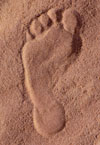 In the early 1980’s, photographer Wayne Eastep lived for three months with the Amrah clan of the Murrah. One of the shots that Eastep later used in his 1986 book Bedouin showed a footprint made in the sand by one of the members of the clan, Nasser al-Amrah al-Murri. “Before printing the book, I took the layouts to Haradh for review by the Murrah,” says Eastep. “The members of the Amrah had not seen any of the photographs, and the version they were looking at had only English captions, which they could not read. But when they turned to this image they spontaneously responded, ‘Ah, Nasser al-Amrah!’ recognizing this image of his footprint as instantly as one would spot a family member’s portrait.” In the early 1980’s, photographer Wayne Eastep lived for three months with the Amrah clan of the Murrah. One of the shots that Eastep later used in his 1986 book Bedouin showed a footprint made in the sand by one of the members of the clan, Nasser al-Amrah al-Murri. “Before printing the book, I took the layouts to Haradh for review by the Murrah,” says Eastep. “The members of the Amrah had not seen any of the photographs, and the version they were looking at had only English captions, which they could not read. But when they turned to this image they spontaneously responded, ‘Ah, Nasser al-Amrah!’ recognizing this image of his footprint as instantly as one would spot a family member’s portrait.” |
This time Mohammed Ali has all 20-odd men present walk past him barefoot. After each man passes, Mohammed Ali points with his stick to direct him into one or the other of two groups. For my walk-by, I try the ploy of removing my shoes but not my socks. I had heard of runaways covering their feet with rags or even strapping cans and pot lids to their feet to confuse trackers.
However, as all good trackers know, and as the texts on the science point out, it is not the prints, “the dead tracks,” but the unique pressure-release points thrown up both in and around the prints that precisely distinguish any track and its maker. Mohammed Ali faultlessly identifies all six sets of tracks and, without a moment’s hesitation, I am apprehended. He admits that on arriving at the scene he immediately spotted our tracks among the rest as those of strangers.
“Shuf!” (“Look!”), he says, pointing at one set of prints in the now-chaotic jumble on the sand patch. “When I see these tracks, it is as if a face stares back at me.”
 |
|
 n Saudi Arabia’s counterterrorism crackdown, trackers are working alongside forensic experts. According to Abdulhadi Saleh al-Murri, administrative head of the Ministry of Interior’s Al-Mujahidi al-Muriyyah (“Tracker Corps”), trackers have assisted in arms and explosives seizures and smuggling interdictions, sometimes under fire. Following the November 8 terrorist bombing of the al-Muhaya residential compound in Riyadh, Abdulhadi Saleh and his corps were among the first on the scene. n Saudi Arabia’s counterterrorism crackdown, trackers are working alongside forensic experts. According to Abdulhadi Saleh al-Murri, administrative head of the Ministry of Interior’s Al-Mujahidi al-Muriyyah (“Tracker Corps”), trackers have assisted in arms and explosives seizures and smuggling interdictions, sometimes under fire. Following the November 8 terrorist bombing of the al-Muhaya residential compound in Riyadh, Abdulhadi Saleh and his corps were among the first on the scene.
Exactly how their skills are deployed is not something officials will freely discuss. “Clearly, with trackers gifted with such acute skills of observation and detection, we are making effective use of them,” says a senior official of the Ministry of Interior. “But while the results of interceptions, seizures and arrests become public, we do not advertise the methods and techniques employed by trackers.”
The utility of trackers is surprisingly high, says the official, despite the development of asphalt roads in nearly all of the kingdom’s population centers. He is quick to point out that, even in modern buildings and on paved surfaces, trackers find crucial clues and even prints. “Try finding the interior of a building or any manmade surface without a film of dust or sand over it at any time of year. You would be surprised what we can see on supposedly clean surfaces,” he says.
Tom Brown agrees. “Master trackers observe tracks differently from everyone else. Our world of tracking is that of infinite detail and intense analysis. Our eyes become geared to the obscure, and in so doing, our ability to follow trails, even over solid rock, becomes as easy as tracking in sand,” he says.
And what of countermeasures that may be used against trackers? “They are up against the collective knowledge of generations,” says Abdulhadi Saleh. “Shoes worn back to front, oversized footwear, contraptions worn over feet, tires changed on vehicles—you name it and we’ve seen it, and it won’t fool us. We’ll know where the tracks are going and where they came from and when. And we’ll usually find out what or who made them.”
|
 |
Peter Harrigan, a free-lance writer based in Jiddah, traveled some 16,000 kilometers across deserts and wildlife reserves in Saudi Arabia on this assignment. "Nearly everyone I met was fascinated by tracking and guiding," he says, "but, beyond anecdotes, few were able to explain how it is done. I’m very lucky to have seen these ancient skills put to use—and put to the test." Harrigan can be reached at harrigan@fastmail.fm. |
|
|